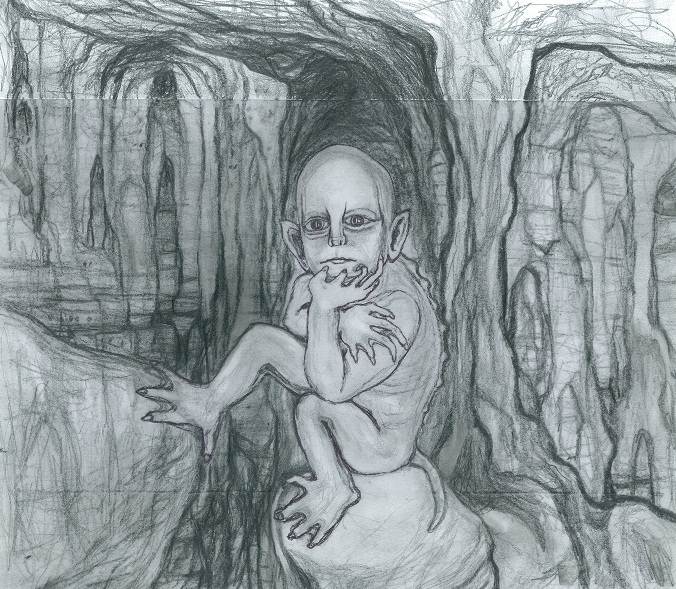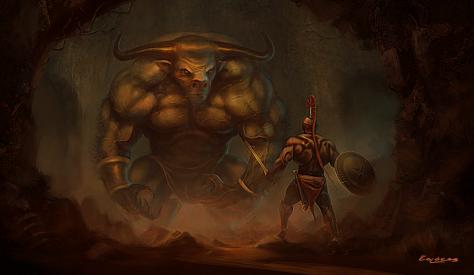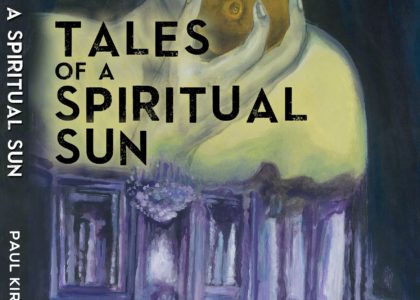
A great many centuries before Jewish and Christian ideas surrounding heaven and hell appeared, the progressive and sometimes outrageous poets, playwrights, historians, and philosophers of classical and pre-Socratic Greece had already bequeathed to the Mediterranean world a pantheistic religion and a literary tradition surrounding majestic gods and goddesses whose behaviours imitated outright those of their mortal subjects. The twelve primary deities, all of which can be loosely associated with psychological and cosmic archetypes, ruled the living world from the mount of heavenly Olympus and were equally capable of virtuous or malicious behaviour. The humanistic mirror with which the ancient Greeks perceived their divinities spilled into more fundamental questions that sought to address life-after-death and the destiny of the human soul. If the divine realm and its inhabitants were morphologically and anatomically comparable to the Earth, then so too must the Underworld, the subterranean abode of the deceased, be a shadowy though sullied duplicate of the latter.
According to Hesiod, the oral poet who first mapped out the mythological terrain as well as the divine and semi-divine family pedigree of ancient Greece, the first conscious derivatives of the primordial chaos, the undifferentiated slime of uncreation, were the physical Earth, Eros or the principle of divine love, the dark Night, and Hades, an infernal region that could be further divided into an upper tier called Erebus and a lower tier called Tartarus. The first was a dimension that welcomed the recently departed, whilst the second a hellish prison designed to torture evildoers. In attempting to institutionalize the religiously flavoured literature, many subsequent mythographers of Hellenism confounded the two aforementioned terms and used either to designate the Underworld. While proceeding in a logical manner Hesiod’s account of creation seems to be a bountiful but bloody and belligerent affair as a prevailing order of deities are supplanted by a new generation, often their own children. One of the bloodiest involved the fearsome Titans and the Olympians, in which the former lost a battle that lasted twelve whole years and were hurled into the depths of Tartarus as a result. The trajectory of this absolute lightlessness and silence to the earth was immense, so immense in fact that an anvil being dropped from heaven would take a whole nine days and nights to get there.
Interestingly, the first account of Hades given by Homer is painstakingly simplistic and bland. Here, Hades appears as a preternatural realm ravaged by inertia and an absence of vitality and force, and it isn’t until much later that the mythographers give us a clearer picture of its geography and ethereal landscape. Entrance to this harrowed abode was by various caverns and deep lakes, with the one most frequently cited being a cave in close proximity to Marmari in the southern Peloponnese called Taenarus. The soul or psyche of a recently departed individual would be guided to an enclosure beyond this spot by Hermes the psychopomp, whereby he or she would come to the River Styx (“Hated”) and its tributaries Phlegethon (“Burning”), Cocytus (“Wailing”), Acheron (“Woe”), Aornis (“Birdless”), and Lethe (“Forgetfulness”). When describing Hadean terrain, tradition aptly keeps to the transcription of a quartet though which four comprise it varies from author to author. Down near the banks of the delta, a decrepit old man euphemistically named Charon (“Bringer of Joy”) waited patiently for the arrival of the deceased individual who would be ferried across the subterranean river once payment in the form of a single obolus was made. All hope of a return to the land of the living was quashed once ethereal footprints were made on black silt abounding on the opposite side. From here, one had a perfect view of the many-gated palace of Hades (or Plouton), a single edifice set in a barren and desolate stretch of fields which brimmed with ashen, wraithlike flowers like asphodel. Continuing along this path, the deceased would be greeted by a three-headed, serpent-tailed dog called Cerberus and steadfast escorted through the gargantuan gates that led to the preternatural meadows. Rulers of this parallel dimension were Hades (or Plouton), brother of Zeus and Poseidon, and his wife Persephone, daughter of Demeter. Hades’ second name means “Wealthy One” and recalls the ripening metals, gems, and semi-precious stones, the expensive and opulent jewellery often entombed with the deceased, and the condition of fecundity that possessed the topsoil soon after the spring equinox. The Underworld was not only a place of death and suffering, but also a transitional state of gravidity whereby the spirit of life could once again return to the earth and yield flowers, fruits, and vegetables. Lest we forget that it was courtesy of Pluto’s tentative intervention that Persephone was allowed to return to the earth provisionally, a decision that satisfied her mother Demeter who then reanimated the rotation of the seasons.
Spending eternity in Hades wouldn’t have been a bland or uneventful affair. There were enough sights there to please the eye as there are rides in Luna Park to satisfy the polygonal curiosity of a ten-year old child. Foremost of the exotic and bloodthirsty revenants was the Lamia, a malevolent and deformed female ogre that cannibalized on human babies, and the Empusae, a vampiric entity that bit the jugular vein of male sleepers as they slept complacent in their beds and drained them of blood. Both were thought be daughters of Hecate, the goddess of witchcraft and magic. Then there were the dreaded Erinyes or Furies, a chthonic triad of vengeful spirits that severely punished wrongdoings and those that had violated a solemn oath; the Keres, bloodthirsty death-spirits with wings that helped an animating life force depart from a severely weakened body; and the Alastor, a demon that tempted men to commit a transgression and then dutifully penalized them for it. Medusa, the snake-haired Gorgon, was also there; unaware that her powers had been nullified by the unfortunate condition of death, she stubbornly went on trying to turn every dead creature to stone. Two residents of the Underworld that differed somewhat from the rest in that they could flit between upper and lower worlds were the male twins, Death and Sleep. By far the more flexible and creative of the two was Sleep, for he could send bits of etheric radiation up to world of the living that materialized as dreams. There were two gates through which they passed to reach animate souls, one made of ivory and the other horn-shaped. False dreams or psychic garbage diffused through first whilst premonitions, meaningful dreams, and precognitive visions tunnelled their way up to the conscious light and erupted in the reposing mind through the second.
There was also a long list of mythical celebrities pervading the Stygian regions. All were former residents of the material plane and all had been damned for offences deemed serious against the circle of mighty Olympians. Punishments for violations in Hades were undoubtedly harsh, relentless and handed down to perpetrators without compunction. Sisyphus, for instance, was a Corinthian king whose everlasting sentence involved rolling a large bounder along a steep slope. This rock would steadfast roll back down before reaching the pinnacle, prompting him to return to his starting position and repeat the perturbing endeavour. The mythical King Tantalus suffered an equivalent fate for the barbaric dismemberment of his own son, a sacrifice which he dared to serve up to the gods at a banquet held in their honour. He was strung over a subterranean lake for his crime and left there to wallow in his own misery. The penalty was perpetuated by the fact that he could not quench his thirst or satisfy his hunger; reaching out for a clump of fruit hanging on the tree instigated a breeze that blew it beyond the limits of his grasp and the action of veering near the surface of the lake for a sip caused the pool to vanish like a mirage. Attempting to draw up water from the same lake from sifters are the Danaids, the fifty daughters of Danaus who attempted to escape the inexorable condition of arranged marriage by assassinating their husbands with a shower of hairpins. Elsewhere, the giant Tityus is pegged out along the Stygian fields whilst vultures devour his liver for an attempted rape of Leto at the behest of her divine twins, Artemis and Apollo, and Ixion, king of the Lapiths, is bound to a spinning solar wheel for attempting to enact the same crime against Hera, Queen of Olympians.
The original conception of Hades as a spiritual dimension beyond death was without the ancient Persian and Egyptian notion of a psychostasia, a final judgement that conferred a specific destiny to each individual soul depending on the moral nature and worth of its lifetime actions. An obvious explanation to this oddity can be found in the cultural presentiments of early Hellenistic civilization. Unlike both the Zoroastrian, Egyptian, and Roman cultural milieu which placed great worth in the value of a judicial mechanism for the resolution of criminal, civil, and administrative affairs, the ancient Greek democratic ideals didn’t extend their virtues to the development of legal science and a legal system revolving around the rights of citizens. Nonetheless, an efflux of cross-cultural exchange eventually influenced Hellenistic religious ideas pertaining to the afterlife and profound evidence for it crops up in a Socratic dialogue composed by the Athenian Plato around c. 380bce. The preeminent philosopher narrates that once the dead were ushered into Hades, they were met by three judges: Aeacus, Rhadamanthus, and Minos. Aeacus, a mythical king of Aegina born to Zeus and the nymph Aegina, was bestowed the task of judging the deeds of expired Europeans. Rhadamanthus and Minos were both sons of Zeus and Europa. It was believed that Rhadamanthus presiding over the Asian souls while the renowned Minos, known to the world as the notorious king of Crete who demanded an annual Athenian sacrifice of seven youths and seven maidens, was granted an overarching authority over the other two as the figure responsible for appeals, imposing sentences, and the implementation of a system of codes by which all souls were tried. Those cleared of moral fraud and shown to be of a generally good disposition were allowed entry into the Elysian Fields, a place where they could delight their senses with ambrosial gifts like singing, dancing, playing musical instruments like the lyre, and revelling in the laughter of flowery meadows. Alternatively those which weighed heavily in favour of treachery, discrimination, ingratitude, disorder, and malevolence were ushered to the abyssal dungeon of torment, to Tartarus. Rulings in which a clear-cut decision could not be made resulted in the soul being sent to the Asphodel Meadows, an ethereal field which somewhat mimicked the earthly plane in its morphology but was a less-than-desirable carbon copy of it.
Only a select few individuals ever managed a lateral glance at the morbid sights of the Underworld whilst they were still alive. Three that spring to mind are the celebrated heroes Odysseus, Orpheus, and Heracles. In the Ithacan soldier-king’s case the witch Circe had advised him that the best way to reach Ithaca was to consult with the soul of the wise seer Tiresias in Hades. Tiresias might, according to Circe, be capable of unravelling the arcanum given that his previous incarnations were not exclusive to one of the two genders. To get there safety Odysseus has to follow the course of the river Oceanus until he arrives at the forked crossroads where the Cocytus and Phlegethon pour themselves into the Acheron. Standing at the mouth of a subterranean cave which leads to Hades Odysseus enacts a ritual that includes pouring a libation to the dead and sacrificing two black animals, a ewe and a ram. Blood flows into the subterranean conduit, attracting all sorts of ghosts and paranormal denizens though Odysseus aptly drew his sword and prevents them from lapping up the blood until Tiresias can fumble his way to the mouth of the cave and consume some of the vital force that empowers the silent dead with speech.
At this point Odysseus is stunned to see the simulacrum of his shipmate Elpenor emanating from the bloody pit; their ship had sailed from the isle of Aeaea in such a hurry that nobody was yet conscious of the fact that the unfortunate sailor had suffered a fatal tumble from roof of Circe’s residence. Satisfied that his friend will now execute the customary burial rights that will enable him to reach Hades proper safely, Elpenor spontaneously vanishes from sight. A short while afterwards Tiresias makes his anticipated appearance and, after tasting the oxygen-rich blood that will enable him to speak, gives voice to a premonitory soliloquy that pinpoints exactly which god is angry (Poseidon), what has angered him (the blinding of Polyphemus), and what can be done to appease him (safeguarding the cattle of the Sun). Tiresias’s imminent departure from the pit allows another more familiar disembodied spirit to come to light, Odysseus’s mother. She comes as the bearer of both good and bad news, announcing that his wife Penelope has remained fiercely faithful to him but that his father is suffering severe despondency owing to the disappearance of his only child.
The ghosts continue their coming and going to the pit, mimicking a disparate chain of pictorial images that come forth into our minds during sleep entirely of their own volition. Next in line is his former commander Agamemnon, who tells Odysseus of the treacherous conspiracy that his scheming wife Clytemnestra successfully executed to his own detriment after he returned home. Other vanquished heroes of the Trojan War also emerge: the mighty warrior Achilles, son of Peleus and the nymph Thetis; Patroclus, Achilles’s comrade and beloved brother-in-arms; and Ajax, son of Telamon and Periboea. Achilles’s own gloominess appears to abate when Odysseus tells him of the marvellous feats enacted in the living sphere by his son, Neoptolemos, though Alex is much less receptive to his advances, still somewhat furious at the post-Trojan tribunal for having awarded Achilles’s armoury to Odysseus instead of himself. Odysseus finds that the ethereal images appearing, pinching out, and then vanishing swiftly are dictated by his own willingness to see them. He sees Tantalus strung beneath one of the branches of his tree, Sisyphus heaving his rock along a steep hill, Tityus’s liver being picked apart by a flock of aggressive vultures, the judge Minos issuing a decree with a golden sceptre in his hand, the shadow of Achilles, the muscle-bound hero Heracles, and the cheerful Orion. Growing uneasy of the large number of ghosts now crowding around the blood pit for a chance to speak, Odysseus flees from the ghastly site and rejoins his seafaring companions. Together they sail back to Aeaea, the isle of Circe, rowing as quickly as possible.
Orpheus, the legendary musician from Thrace, also visited the Underworld. He sought to salvage the life of Eurydice, his newly-wedded wife, by descending to the Stygian darkness and charming the ruling inhabitants with heartfelt songs played on his lyre. Enamoured of his music, Plouton and Persephone agreed to give Eurydice a second chance at life on the condition that he lead the way to the living realm without pivoting to see if she was following until they were both safely out of the deathly shade of the infernal regions. Orpheus wasn’t able to keep his side of the bargain and so Eurydice was sucked back through the steep funnel leading to the Fields of Asphodel, this time for good.
It is most fitting that the strongest man to ever grace the mythological terrain of ancient Greece managed to sneak a peak of the dreaded Hadean landscape, though not of his own volition. The twelfth and most perilous labour assigned to Heracles involved capturing Cerberus, the Hound of Hell, and bringing him to King Eurystheus of Tiryns. Heracles wasn’t one to shy away from any task, no matter how daunting or insuperable it appeared, and he promptly set about his descent to the Underworld through the familiar cave of Taenarus. Crossing the Styx didn’t pose too much of a problem either; Heracles merely struck a frightful pose and frowned, striking terror in Charon who ferried him across without any objections. There he found his old friends Theseus and Peirithous mindlessly glued onto the Chair of Forgetfulness for their hubris in thinking they could abduct and carry off Persephone, Queen of the Underworld. Heracles manages to liberate the bulk of Theseus after a whole lot of tugging and pulling, but heaving Peirithous up proves to be a far thornier endeavour. He eventually comes to terms with the latter’s futile situation and sees no choice but to move onto the task of capturing Cerberus. Scrambling all the way to the Hadean palace, he finds Plouton and Persephone and pleads for their permission to capture the Hound of Hell. At first the couple seems reluctant but they eventually yield to the request when Heracles agrees to tackle the beast barehanded. Confronting and seizing the dreaded monster turns out to be child’s play for the man of steel; he grapples the beast by two of its throats, rolls him into the magical skin of the Nemean lion, slings him over his back, and then charges off to find Eurystheus at Tiryns. The king was so mortified at the sight of Cerberus that he dived into a pithos (large storage jar), refusing to come out until the threat had been removed from his quarters.
Bold and fearless as he was, Heracles paid the Underworld a second visit to rescue a Greek princess by the name of Alcestis. This lady was famed for the fidelity and love she espoused towards the suitor that was picked to become her husband, King Admetus. On the night of their wedding Admetus was remiss in conducting the requisite sacrifice to honour the goddess Artemis. The goddess’s fury was eventually appeased, however this was followed by another predicament in which the three Fates appeared and condemned him to death, a condition that could only be evaded if someone else stepped forth as a willing substitute. Without as much as a thought for the worth of her own life, Alcestis consumed poison and died in his place. Heracles came to the rescue as soon as he heard of Admentus’s horrifying misfortunes. Greatly impressed by the kindness and hospitality expressed towards him when he was an apologetic visitor to Admentus’s residence, Heracles agreed to advocate on the king’s behalf. He descended to Hades and pleaded for the safe return of a cherished soul to the plane of the living. Upon hearing his story, Persephone agreed with Heracles that a grand injustice had befallen Alcestis and decided to grant her freedom. The royal couple enjoyed a stretch of long serendipity from that point onward, siring a son and daughter, Eumelus and Perimele, respectively.
In retrospect one would not be incorrect in stating that a truly Hellenistic conception of the Underworld, the stylistically branded “hell” of later times, did not acknowledge any disembodied forces of pure “good” or “evil”. As progressive, poetic and logical as it might have been though, this cosmological outlook did not remain stagnant for very long. By the fifth century bce, many daimones (demons) born below the aegis of the classical prototype could easily be mistaken for notions of Beelzebub fabricated by the Jews or the viperish and scaly minions lurking in the Christian Purgatory, in Dante’s fourteenth-century epic poem Inferno , and in John Milton’s Paradise Lost (1667). The clearest evidence for this is in a fifth-century fresco painted by Polygnotus of Odysseus’s harrowing sojourn in Hades that adorned a building at the Delphic shrine sacred to Apollo. Sadly, the mural has not survived the ravages of time but we know of it through Pausanias’s painstaking description of Polygnotus’s work. The keen traveller tells us that Polygnotus initiated something of a playful and imaginative departure from the literary orthodoxy of classical Hades in adding personages to his pictorial transcriptions that Odysseus had not seen and which Homer had forgotten to describe. One that stands out because of its petrifying morphology is Eurynomos, a beast-demon with a bluish black complexion and razor-sharp fangs that sat on the black banks of the feared Styx and consumed the rotting flesh of the vilest evildoers. In depicting this demon, Polygnotus was descrying a dream of the future in which the subterranean strata of Hades and its familiar imagery would sear in the cooking pot of the Christian imagination and become an after-death fantastical dungeon of brutality, savagery, and rigid torment.
Indeed, the human propensity to yield to temptations of darkness, to dwell there, to investigate its ever fluctuating landscapes and inhabitants, and to imagine there has become something of a self-fulfilling prophecy and, um, well … sinful.









